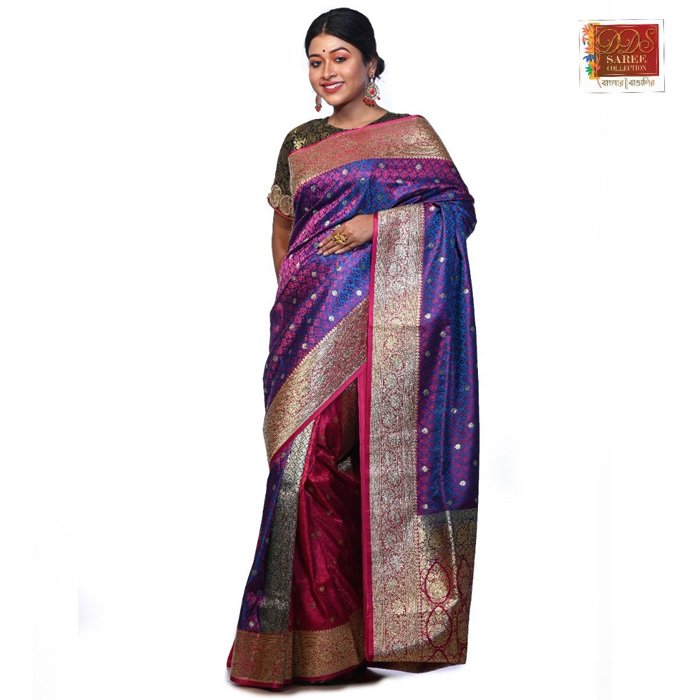Your cart is currently empty!

Turn Heads this Ganesh Chaturthi Draped in a Banarasi Saree!
Ganpati Bappa Morya, Mangalmurti Morya!
With approximately 1 month left to Ganesh Chaturthi, Maharashtra and southwest India have been heating up. The festival was originally a way for people to pray and be set free of their sins. It is believed, that when Lord Ganesha visits the earthly abode he cleanses your life of the evil and corrupt. Devotees emerge from this 10-day celebration with a clean slate for another year. They embark on their journeys towards a life replete with goodwill, honesty, knowledge, and wisdom.
Vinayaka Chaturthi used to be a private affair until the time of Chhatrapati Shivaji Maharaj. During India’s freedom struggle, Lokmanya Tilak’s efforts urged the festival into a public celebration. It was here that the worship of Bappa became synonymous with unity, solidarity, and national integration.
Now, where do clothes fit in the journey? As Ganesh Chaturthi grew into the massive southwest Indian phenomenon, the celebrations began including people showing up in their finest garbs. People would eat the best food, dress in the best clothes and just generally make merry. Before anyone knew it, the festival also became a place to celebrate the splendor of traditional fashion.
Reimagining the Classic Banarasi for Ganesh Chaturthi
Banarasi sarees are among one of India’s most enthralling weaves. These sarees can be readily distinguished by their characteristic intricate floral and foliage motifs. The embroidery is compact and woven in with smaller details like minakari, metallic jhallar, and jal or net-like pattern.
Indian sarees are a treasure trove of traditions, cultural values, and accompanying style statements. Ganesh Chaturthi is just around the corner, what better time for the modern Maharashtrian woman to revel in the rich heritage of a saree than now?
Types of Different Fabrics in Banarasi Sarees
Traditionally banarasi sarees were made of silk, but as time progressed weavers and artisans began experimenting with different makes and fabrics. India developed into a melting potpourri of cultures, traditions, and artistic influences; the original silk morphed into the 3 primary banarasi fabrics of today – Katan (pure silk), Pashmina, and Tussar.
Katan Banarasi
Katan silk originated in Persia and later spread to Mughal India. The women of the royal family were known to adorn themselves with luxurious and intricately designed katan silk sarees. Katan consists of two silk threads twisted together and woven into a light fabric. However, the material is deceptively sturdy. When you buy banarasi sarees made of katan silk, you can rest assured that you are investing in a piece that will outlast the years.
Katan banarasis are the perfect outfit to wear for Ganesh Chaturthi, the lustrous resplendence of the material is befitting the grandeur of the celebrations. Katan in bright colors works best with traditional Maharashtrian nath and thushi.
Pashmina Banarasi
Perhaps if there is any other banarasi fabric that matches katan’s plush silken weaves, it has got to be pashmina banarasis. As you might have already guessed, the fine silk is extracted from the wool of mountain cattle. Unlike pashmina shawls, the fibers in a saree are thinner and thus suitable for every season, even the sticky Mumbai heat during Ganesh Chaturthi. In fact, a pashmina banarasi is one of the lightest feeling banarasis out there.
It is said, pashmina fibres are so fine that an entire saree, the full 9 yards can be made to pass through a finger ring. Owning to the material’s pliability, it is easy to drape. Drape your pashmina banarasi in the original Marathi drape to wow onlookers this Vinayaka Chaturthi.
Tussar Banarasi
Tussar silk differs from mooga and mosa in the fact that it is produced from the larvae of silkworms belonging to the Antheraea genus. These silkworms diet on plants like jamun and oak. Tussar banarasi sarees are immensely popular in the eastern and central-eastern India for their rich texture and deep golden sheen.
Though initially, not as popular as katan and pashmina, tussar banarasis are fast becoming a Ganesh Chaturthi favorite. When you buy a banarasi saree, you will be pleasantly surprised by the raw, uncut, and yet immensely sophisticated finish of tussar. Tussar banarasis are usually crafted with floral and foliage motifs to bring out the underlying hint of nature.
The fabric is harder to manipulate into complicated drapes but say what you will, nothing beats a classic tussar banarasi saree’s sheer magnificence. The look can be further enhanced with a kolhapuri saaj.
Celebrate ganpati bappa and the abundance of heritage behind the festival with a full glam banarasi look. Buy banarasi sarees online at DDS Saree Collection’s website.


Leave a Reply